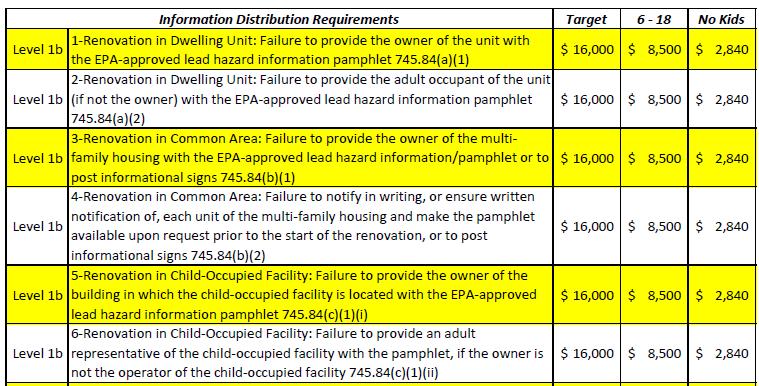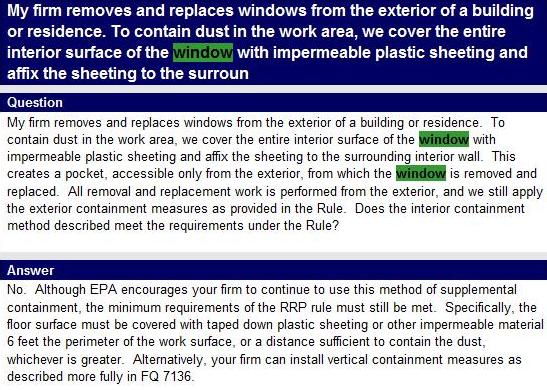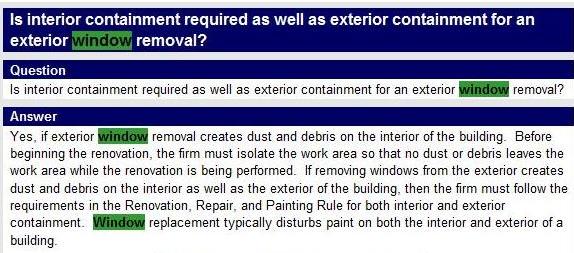 In yesterday’s article, we did a quick overview of the RRP’s enforcement policies, looked at the current exemptions, what their 4 levels of enforcement options are, and provided a ton of links to help you hopefully avoid getting into trouble in the first place. In today’s article, we are going to delve a little deeper into the process, some of the devil in the detail issues, and point out some of the whoopsies and hypocrisy found in it.
In yesterday’s article, we did a quick overview of the RRP’s enforcement policies, looked at the current exemptions, what their 4 levels of enforcement options are, and provided a ton of links to help you hopefully avoid getting into trouble in the first place. In today’s article, we are going to delve a little deeper into the process, some of the devil in the detail issues, and point out some of the whoopsies and hypocrisy found in it.
Violations of the RRP:
As we discussed yesterday, if the EPA decides you have committed a violation, you are guilty – end of story. The question for them then boils down to how severe the penalty will be. If this is your first minor penalty with a relatively low potential of harm, you may simply get off with a letter of non-compliance. With that being said…
The failure or refusal to comply with any requirement of the PRE, RRP, or LBP Activities Rules is a prohibited act under Section 409 of TSCA (15 U.S.C. § 2689) and civil penalties can be assessed to address such violations pursuant to Section 16 of TSCA (15 U.S.C. § 2615) for each violation of Section 409. A civil penalty action is the preferred enforcement response for most violations.
Time is of the Essence:
While they do have an option of using the court systems, most cases will probably be handled administratively. The first thing I would recommend you do if you receive a letter from the EPA (Civil or Non-Compliance) is to talk to your lawyer before responding. I hope that you have already done so before this, so they are not spending a few days trying to get up to speed on this. One major reason why time is of essence is that you only have 15 days to request a hearing based on the date on the notice.
Computing the Penalty:
Per 15 U.S.C. 2615(a)(2)(B) “…the Administrator shall take into account the nature, circumstances, extent, and gravity of the violation or violations and, with respect to the violator, ability to pay, effect on ability to continue to do business, any history of prior such violations, the degree of culpability, and such other matters as justice may require.” Needless to say, this takes up 18 pages in the policy, so here is a quick Clif Note’s version of it.
Determine the number of violations:
- Each requirement is separate & distinct – for example, if you fail to; Remove all objects, Cover all the ducts, Close the windows &/or doors, Tape down the plastic, & transport dust outside the room, you are looking at 5 separate & distinct violations
- Using the example above – if you were to do this in only one house with 6 rooms that you worked in – you are still looking at only 5 violations
- Using the example above – if you were working on a 4-plex, you were required to follow all those steps four times; thus you now have 5 separate & distinct violations that you failed to abide by 4 times for a total of 20 violations.
Determine the Economic Benefit gained from non-compliance:
You will love this little footnote” Determining economic benefit is not specifically required by the Act, but is authorized under the “as justice may require” factor of 15 U.S. C. § 2615(a)(2)(B).” This “economic benefit” should be calculated when a “significant benefit” is realized based on non-compliance. Be prepared to grab you ankles as this “significant benefit” equates to you making a profit of $50 or more per room. Do I really need to say that they use a separate system to determine what this amount is, than the one that says it will only add $8 to $154 in costs?
Determine the Gravity Based Penalty:
There are two main factors that they use to figure out the penalty; the probability of said action harming someone or the program’s effectiveness (i.e. “level” shown on the left side) and the extent that said harm could cause. The extent portion is located on the far right of the attached spreadsheet and simply applies to the age of anyone being present or affected. (Full spreadsheet)
Final Steps:
After all of the above has been figured out, and added together, they will start crunching numbers based on your past history, ability to pay, how cooperative you were, if you are in any way tied into other companies, etc… If you had replied in a timely fashion, you may have a hearing where you can present evidence, challenge the findings, plead for mercy, etc… The one main thing to remember is that you are already guilty and you must prove that you are not culpable or guilty. If you wish to fight this in court, you may do so, but you should remember that everything stated and turned in to them is admissible in court – did I mention earlier that you should probably have a lawyer?
Whoopsies & Hypocrisy (just a few found without even looking that hard):
- Amazingly, there are quite a few important pieces or regulations missing from this document, and if you know the way most bureaucracies work, this generally leads to those issues being ignored by enforcement officials & other issues.
- New & improved Information Disclosure to the Homeowners – required, but not listed
- Test Result Notifications – required, but not listed
- Handing out the Renovate Right pamphlet, is one of the biggest issues discussed in the policy – as they constantly tie it in using words or phrases like vital, inform, enable them to take precautions, etc… I love how they talk about this book as if it is a silver bullet and will do so much good, yet they still refuse to actually educate the public. As a quick side note to the EPA, I still get their signatures as required, but in most cases, they have already tossed the book in the trash, without reading it…
- Discrepancies between Abatement (where lead is known to be present) and RRP (unless it was built in the 50’s or before the chances that lead is there are slim)
- Open Flame Burning is a Level 1A $37,500 fine for RRP but only a Level 2A $30,000 fine for abatement contractors
- Same thing for using sanders, etc… without a HEPA attachment
- This one falls under the; Are you F$%^ing kidding me — Abatement Contractors “48-Target Housing and Child-occupied Facilities: Failure to collect the required dust samples from the prescribed surfaces in the designated rooms after conducting an abatement with no containment” – what an abatement project where lead is present can be done with no containment whatsoever and only get a Level 4A fine for $15,000
- Another one with the same fine? “49-Target Housing and Child-occupied Facilities: Failure to conduct a visual inspection and clean horizontal, outdoor surfaces of visible dust and debris, perform visual inspection for paint chips on the dripline and remove and properly dispose of any paint chips found following an exterior paint abatement” we are looking at a $37,500 fine for this and lead may not even be present?
Final Thoughts / Best Practices:
The best way to avoid this mess is to follow the advice many of us have stated numerous times – Know what the actual regulation states and follow that – The Regulation
Be careful following other’s advice (yes folks, even mine), or relying even on information found on the EPA’s site, or other government agencies – they are occasionally wrong and they offer you no protection if you are brought in for a hearing. Here is just one quick example of the bad & contradictory info that can be found even on the EPA’s site;
This FAQ numbered 7195 is blatantly wrong per the regulation, and this (along with a few other steps) is actually a well-established abatement procedure that has been used for years. To top this off, there is another FAQ where they describe a method of containing the work are.
This FAQ numbered 6795 is actually correct based on the regulation




SLS_Construction, I am so glad that you found the information on our website useful! It means a lot to me!
I look forward to reading more articles on your blog!
Thank you for the great job you are doing to help contractors understand the nuances of the EPA RRP rule. We also have some resources on our website that you might find helpful
.
First thanks not only for the comment, but helping educate contractors and others about this. I actually used your EPA FAQ feature to find the second FAQ above – I knew it was out there as I had referenced it before, but because of the way they sort their’s it was almost impossible to find.
Thank you for the great job you are doing to help contractors understand the nuances of the EPA RRP rule. We also have some resources on our website that you might find helpful
.
First thanks not only for the comment, but helping educate contractors and others about this. I actually used your EPA FAQ feature to find the second FAQ above – I knew it was out there as I had referenced it before, but because of the way they sort their’s it was almost impossible to find.
SLS_Construction, I am so glad that you found the information on our website useful! It means a lot to me!
I look forward to reading more articles on your blog!